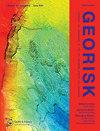用逆速度法预测边坡破坏时间
IF 4.8
3区 工程技术
Q1 ENGINEERING, GEOLOGICAL
Georisk-Assessment and Management of Risk for Engineered Systems and Geohazards
Pub Date : 2022-11-17
DOI:10.1080/17499518.2022.2132263
引用次数: 3
摘要
逆速度法是预测边坡破坏时间的一种常用方法。当应用INV方法时,可以假设逆速度分别是时间的线性函数和非线性函数,在本文中分别称为线性和非线性INV方法。文献中很少有关于使用这两种类型的INV方法的指南。在本文中,使用具有55个案例历史的滑坡数据库来评估线性和非线性INV方法的性能。研究发现,在应用非线性INV方法时,可能会遇到两种类型的陷阱,即鞍点和病态Hessian矩阵。对于本文研究的滑坡,线性INV方法不存在这两个陷阱。当遇到这些陷阱时,基于非线性INV方法预测的失效时间可能与实际边坡失效时间显著不同。对于本文研究的滑坡,线性INV方法不仅比非线性INV方法更稳定,而且更准确。建议在未来的应用中,线性INV方法应优先于非线性INV方法。本文章由计算机程序翻译,如有差异,请以英文原文为准。
On prediction of slope failure time with the inverse velocity method
ABSTRACT The inverse velocity (INV) method is widely used for predicting the slope failure time. When applying the INV method, the inverse velocity can be assumed to be a linear and non-linear function of time, respectively, which are called linear and non-linear INV methods in this paper, respectively. Very few guidance is available in the literatures on the use of the two types of INV methods. In this paper, the performances of the linear and non-linear INV methods are assessed using a landslide database with 55 case histories. It is found that, two types of pitfalls may be encountered when applying the non-linear INV method, i.e. the saddle point and the ill-conditioned Hessian matrix. For the landslides examined in this paper, the linear INV method is free from the two pitfalls. When these pitfalls are encountered, the failure time predicted based on the non-linear INV methods may be significantly different from the actual slope failure time. For the landslides examined in this paper, the linear INV method is not only more stable, but also more accurate than the non-linear INV method. It is suggested that the linear INV method should be preferred over the non-linear INV method in future applications.
求助全文
通过发布文献求助,成功后即可免费获取论文全文。
去求助
来源期刊
CiteScore
8.70
自引率
10.40%
发文量
31
期刊介绍:
Georisk covers many diversified but interlinked areas of active research and practice, such as geohazards (earthquakes, landslides, avalanches, rockfalls, tsunamis, etc.), safety of engineered systems (dams, buildings, offshore structures, lifelines, etc.), environmental risk, seismic risk, reliability-based design and code calibration, geostatistics, decision analyses, structural reliability, maintenance and life cycle performance, risk and vulnerability, hazard mapping, loss assessment (economic, social, environmental, etc.), GIS databases, remote sensing, and many other related disciplines. The underlying theme is that uncertainties associated with geomaterials (soils, rocks), geologic processes, and possible subsequent treatments, are usually large and complex and these uncertainties play an indispensable role in the risk assessment and management of engineered and natural systems. Significant theoretical and practical challenges remain on quantifying these uncertainties and developing defensible risk management methodologies that are acceptable to decision makers and stakeholders. Many opportunities to leverage on the rapid advancement in Bayesian analysis, machine learning, artificial intelligence, and other data-driven methods also exist, which can greatly enhance our decision-making abilities. The basic goal of this international peer-reviewed journal is to provide a multi-disciplinary scientific forum for cross fertilization of ideas between interested parties working on various aspects of georisk to advance the state-of-the-art and the state-of-the-practice.

 求助内容:
求助内容: 应助结果提醒方式:
应助结果提醒方式:


